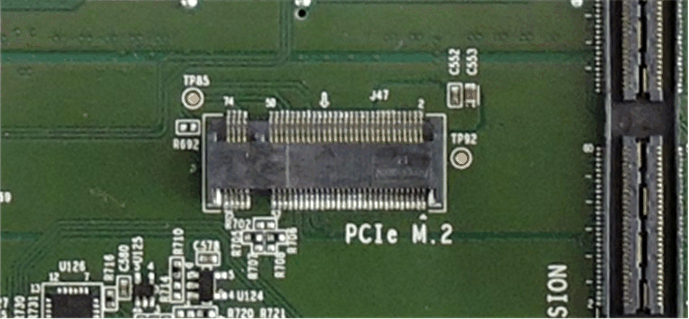SPRUIS4E March 2022 – January 2024
- 1
- Jacinto7 J721E/DRA829/TDA4VM Evaluation Module (EVM)
- Trademarks
- 1Introduction
- 2J721E EVM Overview
- 3EVM User Setup/Configuration
-
4J721E EVM Hardware Architecture
- 4.1 J721E EVM Hardware Top level Diagram
- 4.2 J721E EVM Interface Mapping
- 4.3 I2C Address Mapping
- 4.4 GPIO Mapping
- 4.5 Power Supply
- 4.6 Reset
- 4.7 Clock
- 4.8 Memory Interfaces
- 4.9 MCU Ethernet Interface
- 4.10 QSGMII Ethernet Interface
- 4.11 PCIe Interface
- 4.12 USB Interface
- 4.13 CAN Interface
- 4.14 FPD Interface (Audio Deserializer)
- 4.15 FPD Panel Interface (DSI Video Serializer)
- 4.16 Display Serial Interface (DSI) FPC
- 4.17 Audio Interface
- 4.18 Display Port Interface
- 4.19 MLB Interface
- 4.20 I3C Interface
- 4.21 ADC Interface
- 4.22 RTC Interface
- 4.23 Apple Authentication Header
- 4.24 EVM Expansion Connectors
- 4.25 ENET Expansion Connector
- 4.26 CSI Expansion Connector
- 5Revision History
4.11.3 M.2 PCIe Interface
Common Processor board supports 2 Lane PCIe M2.0 standard, to interface external SSD device.
 Figure 4-25 PCIe Interface for
SERDES2
Figure 4-25 PCIe Interface for
SERDES2M.2 series receptacle with M-Keyed Mfr. Part# MDT320M01001 is used to attach the external SSD device on common processor board. The x2 lane PCIe interface signals SERDES2 of J721E SoC will be terminated with receptacle. SoC_I2C0 is used for SMBUS access. Voltage level translator (TCA9543APWR) circuit will be used to change the I/O level of SMBUS signals to 1.8 V. The link activation signal (WKUP) from PCIe connector is terminated to the test point TP85.
Reset: Reset signal to the SSD/add on module is controlled by GPIO expander. The GPIO signal is pulled low with a resistor 10K by default to ensure PCIe Reset (#PERST) remains asserted until SoC releases reset.
Clock: A clock generator (CDCI #2) is provided to drive 100MHz HCSL clock for PCIe add on cards and J721E SoC. Resistor options are provided to select the clock source either from SoC or clock generator.